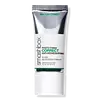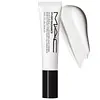What's inside
What's inside
 Key Ingredients
Key Ingredients

 Benefits
Benefits

 Concerns
Concerns

 Ingredients Side-by-side
Ingredients Side-by-side

Water
Skin ConditioningDimethicone
EmollientVinyl Dimethicone/Methicone Silsesquioxane Crosspolymer
Methyl Trimethicone
Skin ConditioningButylene Glycol
HumectantDimethicone/Vinyl Dimethicone Crosspolymer
Skin ConditioningGlycerin
HumectantSilica
AbrasiveHydroxyethyl Urea
HumectantAlgae Extract
EmollientRosa Hybrid Flower Extract
Skin ConditioningFuscoporia Obliqua Sclerotium Extract
Skin ConditioningLycium Chinense Fruit Extract
AntioxidantLactobacillus Ferment
Skin ConditioningVaccinium Angustifolium Fruit Extract
Skin ProtectingVaccinium Macrocarpon Fruit Extract
AstringentPoria Cocos Sclerotium Extract
AstringentCaffeine
Skin ConditioningYeast Extract
Skin ConditioningSorbitol
HumectantSodium Polyaspartate
HumectantEthylhexylglycerin
Skin ConditioningPantethine
EmollientTrehalose
HumectantSodium Hyaluronate
HumectantIsohexadecane
EmollientIsopropyl Isostearate
EmollientPPG-15 Stearyl Ether
EmollientPEG-8 Dimethicone
EmulsifyingPolyglyceryl-3 Disiloxane Dimethicone
Skin ConditioningPolyglyceryl-3 Polydimethylsiloxyethyl Dimethicone
Skin ConditioningTrimethylsiloxysilicate
EmollientAmmonium Acryloyldimethyltaurate/Vp Copolymer
Acrylamide/Sodium Acryloyldimethyltaurate Copolymer
Emulsion StabilisingPolysorbate 80
EmulsifyingDisodium EDTA
Tin Oxide
AbrasiveCellulose
AbsorbentSynthetic Fluorphlogopite
Triethoxycaprylylsilane
Tocopheryl Acetate
AntioxidantTocopherol
AntioxidantBHT
AntioxidantSodium Dehydroacetate
PreservativePotassium Sorbate
PreservativePhenoxyethanol
PreservativeCI 77891
Cosmetic ColorantCI 77288
Cosmetic ColorantMica
Cosmetic ColorantCI 77163
Cosmetic ColorantCI 77492
Cosmetic ColorantWater, Dimethicone, Vinyl Dimethicone/Methicone Silsesquioxane Crosspolymer, Methyl Trimethicone, Butylene Glycol, Dimethicone/Vinyl Dimethicone Crosspolymer, Glycerin, Silica, Hydroxyethyl Urea, Algae Extract, Rosa Hybrid Flower Extract, Fuscoporia Obliqua Sclerotium Extract, Lycium Chinense Fruit Extract, Lactobacillus Ferment, Vaccinium Angustifolium Fruit Extract, Vaccinium Macrocarpon Fruit Extract, Poria Cocos Sclerotium Extract, Caffeine, Yeast Extract, Sorbitol, Sodium Polyaspartate, Ethylhexylglycerin, Pantethine, Trehalose, Sodium Hyaluronate, Isohexadecane, Isopropyl Isostearate, PPG-15 Stearyl Ether, PEG-8 Dimethicone, Polyglyceryl-3 Disiloxane Dimethicone, Polyglyceryl-3 Polydimethylsiloxyethyl Dimethicone, Trimethylsiloxysilicate, Ammonium Acryloyldimethyltaurate/Vp Copolymer, Acrylamide/Sodium Acryloyldimethyltaurate Copolymer, Polysorbate 80, Disodium EDTA, Tin Oxide, Cellulose, Synthetic Fluorphlogopite, Triethoxycaprylylsilane, Tocopheryl Acetate, Tocopherol, BHT, Sodium Dehydroacetate, Potassium Sorbate, Phenoxyethanol, CI 77891, CI 77288, Mica, CI 77163, CI 77492
Water
Skin ConditioningButylene Glycol
HumectantOlea Europaea Fruit Oil
MaskingIsononyl Isononanoate
EmollientSimmondsia Chinensis Seed Oil
EmollientGlycerin
HumectantOctyldodecanol
EmollientHydroxyethyl Acrylate/Sodium Acryloyldimethyl Taurate Copolymer
Emulsion StabilisingPolyglyceryl-2 Triisostearate
EmulsifyingTocopheryl Acetate
AntioxidantSodium Hyaluronate
HumectantSqualane
EmollientHordeum Vulgare Extract
EmollientTriticum Vulgare Germ Extract
Skin ConditioningNiacinamide
SmoothingSorbitol
HumectantTrehalose
HumectantParfum
MaskingDimethicone
EmollientCetyl PEG/PPG-10/1 Dimethicone
EmulsifyingSodium Polyaspartate
HumectantPolymethylsilsesquioxane
Hydroxyethyl Urea
HumectantHdi/PPG/Polycaprolactone Crosspolymer
Octyldodecyl Xyloside
EmulsifyingQuaternium-90 Bentonite
Polysorbate 60
EmulsifyingSodium Chloride
MaskingSilica
AbrasivePropylene Carbonate
SolventIsopropyl Isostearate
EmollientCaprylyl Glycol
EmollientHexylene Glycol
EmulsifyingHydrogenated Polyisobutene
EmollientPEG-30 Dipolyhydroxystearate
EmulsifyingSorbitan Isostearate
EmulsifyingBenzyl Salicylate
PerfumingLimonene
PerfumingLinalool
PerfumingPentaerythrityl Tetra-Di-T-Butyl Hydroxyhydrocinnamate
AntioxidantDisodium EDTA
Phenoxyethanol
PreservativePotassium Sorbate
PreservativeSodium Dehydroacetate
PreservativeWater, Butylene Glycol, Olea Europaea Fruit Oil, Isononyl Isononanoate, Simmondsia Chinensis Seed Oil, Glycerin, Octyldodecanol, Hydroxyethyl Acrylate/Sodium Acryloyldimethyl Taurate Copolymer, Polyglyceryl-2 Triisostearate, Tocopheryl Acetate, Sodium Hyaluronate, Squalane, Hordeum Vulgare Extract, Triticum Vulgare Germ Extract, Niacinamide, Sorbitol, Trehalose, Parfum, Dimethicone, Cetyl PEG/PPG-10/1 Dimethicone, Sodium Polyaspartate, Polymethylsilsesquioxane, Hydroxyethyl Urea, Hdi/PPG/Polycaprolactone Crosspolymer, Octyldodecyl Xyloside, Quaternium-90 Bentonite, Polysorbate 60, Sodium Chloride, Silica, Propylene Carbonate, Isopropyl Isostearate, Caprylyl Glycol, Hexylene Glycol, Hydrogenated Polyisobutene, PEG-30 Dipolyhydroxystearate, Sorbitan Isostearate, Benzyl Salicylate, Limonene, Linalool, Pentaerythrityl Tetra-Di-T-Butyl Hydroxyhydrocinnamate, Disodium EDTA, Phenoxyethanol, Potassium Sorbate, Sodium Dehydroacetate
 Reviews
Reviews

Ingredients Explained
These ingredients are found in both products.
Ingredients higher up in an ingredient list are typically present in a larger amount.
Butylene Glycol (or BG) is used within cosmetic products for a few different reasons:
Overall, Butylene Glycol is a safe and well-rounded ingredient that works well with other ingredients.
Though this ingredient works well with most skin types, some people with sensitive skin may experience a reaction such as allergic rashes, closed comedones, or itchiness.
Learn more about Butylene GlycolDimethicone is a type of synthetic silicone created from natural materials such as quartz.
What it does:
Dimethicone comes in different viscosities:
Depending on the viscosity, dimethicone has different properties.
Ingredients lists don't always show which type is used, so we recommend reaching out to the brand if you have questions about the viscosity.
This ingredient is unlikely to cause irritation because it does not get absorbed into skin. However, people with silicone allergies should be careful about using this ingredient.
Note: Dimethicone may contribute to pilling. This is because it is not oil or water soluble, so pilling may occur when layered with products. When mixed with heavy oils in a formula, the outcome is also quite greasy.
Learn more about DimethiconeDisodium EDTA plays a role in making products more stable by aiding other preservatives.
It is a chelating agent, meaning it neutralizes metal ions that may be found in a product.
Disodium EDTA is a salt of edetic acid and is found to be safe in cosmetic ingredients.
Learn more about Disodium EDTAGlycerin is already naturally found in your skin. It helps moisturize and protect your skin.
A study from 2016 found glycerin to be more effective as a humectant than AHAs and hyaluronic acid.
As a humectant, it helps the skin stay hydrated by pulling moisture to your skin. The low molecular weight of glycerin allows it to pull moisture into the deeper layers of your skin.
Hydrated skin improves your skin barrier; Your skin barrier helps protect against irritants and bacteria.
Glycerin has also been found to have antimicrobial and antiviral properties. Due to these properties, glycerin is often used in wound and burn treatments.
In cosmetics, glycerin is usually derived from plants such as soybean or palm. However, it can also be sourced from animals, such as tallow or animal fat.
This ingredient is organic, colorless, odorless, and non-toxic.
Glycerin is the name for this ingredient in American English. British English uses Glycerol/Glycerine.
Learn more about GlycerinIsopropyl isodecanoate is a lipid created from isopropyl alcohol and isostearic acid. It is an emollient and leaves skin feeling soft.
Emollients create a thin barrier that traps moisture underneath, hydrating the skin.
This ingredient may not be fungal-acne safe.
Learn more about Isopropyl IsostearatePhenoxyethanol is a preservative that has germicide, antimicrobial, and aromatic properties. Studies show that phenoxyethanol can prevent microbial growth. By itself, it has a scent that is similar to that of a rose.
It's often used in formulations along with Caprylyl Glycol to preserve the shelf life of products.
Potassium Sorbate is a preservative used to prevent yeast and mold in products. It is commonly found in both cosmetic and food products.
This ingredient comes from potassium salt derived from sorbic acid. Sorbic acid is a natural antibiotic and effective against fungus.
Both potassium sorbate and sorbic acid can be found in baked goods, cheeses, dried meats, dried fruit, ice cream, pickles, wine, yogurt, and more.
You'll often find this ingredient used with other preservatives.
Learn more about Potassium SorbateSilica, also known as silicon dioxide, is a naturally occurring mineral. It is used as a fine, spherical, and porous powder in cosmetics.
Though it has exfoliant properties, the function of silica varies depending on the product.
The unique structure of silica enhances the spreadability and adds smoothness, making it a great texture enhancer.
It is also used as an active carrier, emulsifier, and mattifier due to its ability to absorb excess oil.
In some products, tiny microneedles called spicules are made from silica or hydrolyzed sponge. When you rub them in, they lightly polish away dead skin layers and enhance the penetration of active ingredients.
Learn more about SilicaThis ingredient is a preservative with antimicrobial properties. It is the sodium salt of dehydroacetic acid.
It is especially effective at preventing bacterial and fungal growth in low concentrations.
Sodium Hyaluronate is hyaluronic acid's salt form. It is commonly derived from the sodium salt of hyaluronic acid.
Like hyaluronic acid, it is great at holding water and acts as a humectant. This makes it a great skin hydrating ingredient.
Sodium Hyaluronate is naturally occurring in our bodies and is mostly found in eye fluid and joints.
These are some other common types of Hyaluronic Acid:
Learn more about Sodium HyaluronateWe don't have a description for Sodium Polyaspartate yet.
Sorbitol is a sugar alcohol. It is a hydrating and moisturizing agent created from the reduction process of glucose.
Most sorbitol is usually made from potato starch. It is also found in fruits such as apples and pears.
As a humectant, Sorbitol helps draw water to the skin. This helps keep the skin hydrated. Sorbitol also helps create a thicker texture in products. You might find sorbitol in your toothpaste and other gels.
It is a non-irritating ingredient that is great for those with dry skin.
Sorbitol is a prebiotic. It helps promote the growth of healthy bacteria on your skin. The bacteria on your skin form a microbiome. This microbiome helps protect your skin from infection and harmful bacteria.
Learn more about SorbitolTocopheryl Acetate is AKA Vitamin E. It is an antioxidant and protects your skin from free radicals. Free radicals damage the skin by breaking down collagen.
One study found using Tocopheryl Acetate with Vitamin C decreased the number of sunburned cells.
Tocopheryl Acetate is commonly found in both skincare and dietary supplements.
Learn more about Tocopheryl AcetateTrehalose is a disaccharide made of two glucose molecules (glucose is sugar!). Trehalose is used to help moisturize skin. It also has antioxidant properties.
As a humectant, trehalose helps draw moisture from the air to your skin. This helps keep your skin hydrated.
Due to its antioxidant properties, trehalose may help with signs of aging. Antioxidants help fight free-radical molecules, unstable molecules that may damage your skin.
In medicine, trehalose and hyaluronic acid are used to help treat dry eyes.
Some animals, plants, and bacteria create trehalose as a source of energy to survive freeze or lack of water.
Learn more about TrehaloseWater. It's the most common cosmetic ingredient of all. You'll usually see it at the top of ingredient lists, meaning that it makes up the largest part of the product.
So why is it so popular? Water most often acts as a solvent - this means that it helps dissolve other ingredients into the formulation.
You'll also recognize water as that liquid we all need to stay alive. If you see this, drink a glass of water. Stay hydrated!
Learn more about Water